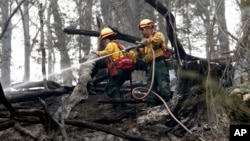Thick smoke has settled over a wide area of the southern Appalachians, where dozens of uncontrolled wildfires are burning through decades of leaf litter and people breathe in tiny bits of the forest with every gulp of air.
It's a constant reminder of the threat to many small mountain communities, where relentless drought and now persistent fires and smoke have people under duress.
“A lot of the ladies just went to tears and said this happens in other places, it doesn't happen here,” pastor Scott Cates said as townspeople donated water, cough drops and other supplies for the firefighters at the Liberty Baptist Church in Tiger, Georgia.
Here, these fires don't sleep. They burn through the night, through the now-desiccated tinder of deciduous forests accustomed to wet, humid summers and autumns.
“It doesn't die down after dark,” said fire Capt. Ron Thalacker, who came from Carlsbad, New Mexico, with a fire engine that now draws water from streams and ponds to spray on hotspots in Georgia's Rabun County, near the epicenter of the southern fires.
Large, wind-driven fires that scorch pine forests in the West often burn in the tree tops and mellow out at night, but these fires are clinging to the ground and actively burning 24 hours a day, said firefighter Chad Cullum of Billings, Montana.
Cullum spoke briefly, as flames rolled down a mountainside behind him. Then he ordered everyone to get out. “We need to leave,” he said sternly, ushering people to move down a rocky dirt road.
More than 5,000 firefighters and support personnel, including many veterans of wildfires in the arid West, and 24 helicopters are battling blazes in the fire zone, which has spread from northern Georgia and eastern Tennessee into eastern Kentucky, the western Carolinas and parts of surrounding states.
Nationally, “there's a pretty good ability to help out the South right now,” said Jennifer Jones, a spokeswoman with the U.S. Forest Service. Reinforcements have arrived from at least 37 states, the District of Columbia and Puerto Rico, she said this week.
One man died Wednesday on eastern Kentucky's Mountain Parkway, where smoke decreased visibility. Kentucky State Police said about 14 others were injured in a series of wrecks on both sides of the road.
Trooper Scott Ferrell said a coal truck driver died when he got out of his truck to check on a driver whose vehicle had hit the truck and then was hit by a third vehicle. About 15 vehicles were involved in the chain reaction collisions that closed the highway for nearly 10 hours, Ferrell said.
More than 30 large fires remain uncontained, and overall, a total of 128,000 acres has burned, or about nine times the size of Manhattan.
Firefighters got a lucky break when a fire reversed direction, turning away from the Trail of Tears, which marks the route where the Cherokee and other Indians were forcibly removed from their lands in the 1800s. In national forests, following procedures approved by the tribes, heavy equipment isn't allowed within 750 feet of the trail bed unless life or property is threatened, U.S. Forest Service spokesman Terry McDonald said.
Tim Free, a lifelong resident of Rabun County, broke down with emotion as he described how elderly neighbors are struggling with relentless smoke, so thick it blocks the sun. “What we're fortunate to have here is people who care about people,” he said.
“Anybody that's outside of their homes is going to have to have something that will basically lubricate their throats - cough drops, lozenges or even a stick of peppermint,” Free said. “Just to get a little lubricant in your eyes is something that's needed daily because of the smoke.”
Just across the state line in North Carolina, three firefighters were battling the Party Rock fire near the town of Lake Lure after driving 23 hours from Albuquerque, New Mexico.
“There was a request for help. We have units available to assist,” Edward Nieto said.
There hasn't been a fire in the Lake Lure area in a long time, so the forest floor is thick with flammable material, and falling autumn leaves are encouraging the flames to spread, said Victoria Tillotson, a spokeswoman with the North Carolina Forest Service.
A total of 850 people were fighting the Party Rock blaze, which grew to more than 5,700 acres on Tuesday and was still just 19 percent contained, she said.
Randle Montgomery recalled watching television coverage of wildfires in California and considering himself lucky. He never expected a 4,500-acre blaze to threaten Lake Lure, where he works, and Black Mountain, where he's lived for 16 years.
“The way this thing takes off, they'll get it contained, and it just depends on the wind, but it's turned so many times on us,” said Montgomery, 47. “And it's got everybody pretty much on edge.”
Tom Stokesberry, an emergency medical technician from Six Rivers National Forest in California, arrived in Georgia's Rabun County on Veterans Day.
“The goal is to keep this line intact,” Stokesberry said, pointing to a narrow, winding dirt road between a burning mountainside and a pasture that, so far, has been untouched by the fire.
The smoke is hiding the sun in town, but out at the fire's edge, it appears blood red.
“We call that the red eye of the dragon,” Cullum says.







